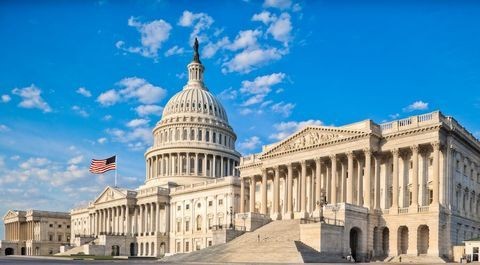Congress Passes New Customs Bill Focused on Strong Enforcement and Trade Facilitation Policies
Client Alert | 8 min read | 02.12.16
On February 11, following a bicameral conference committee to reconcile the House and Senate versions, Congress passed the Trade Facilitation and Trade Enforcement Act of 2015 (the Act), a major customs and international trade bill designed to modernize U.S. Customs and Border Protection's (CBP or Customs) procedures, promote trade facilitation, prioritize certain trade issues, and strengthen enforcement of U.S. international trade laws. Notably, the Act provides the administration multiple new tools to achieve these goals, including:
- The establishment of formal duty evasion investigation and prevention programs.
- Importer risk assessment and importer of record programs.
- New requirements that customs brokers identify importers to CBP.
- Import-related intellectual property rights enforcement initiatives.
- Changes in classification and duty rates for certain textile and apparel imports.
- An interagency Import Safety Working Group.
- Trade facilitation provisions related to the de minimis value for duty-free entry, returned imports, residue of cargo, and duty drawback.
- Increase cooperation and partnerships with the private sector.
- An expanded State Trade Expansion Program.
The House passed the Act last December by a vote of 256-158. With Thursday's 75-20 Senate vote in favor, the legislation moves to the president's desk for signature. The White House has already said the president will sign the bill into law. Thus, U.S. importers, exporters, and manufacturers should become familiar with the below provisions and begin adapting to maximize opportunities and navigate challenges presented by the new U.S. customs and international trade landscape and regime.
Duty Evasion Prevention
The Act establishes within CBP a Trade Law Remedy Enforcement Division charged with:
- Developing and administering policies to prevent and counter evasion. Evasion is defined as bringing merchandise into U.S. customs territory by any means that is material and false or results in the reduction or elimination of applicable antidumping and countervailing (AD/CVD) duties.
- Directing enforcement and compliance assessment activities concerning evasion.
- Developing and conducting risk assessment targeting of importers that present the risk of potentially evading imports.
The Act provides procedures and timelines for CBP to investigate allegations of evasion of AD/CVD duties filed by interested parties—U.S. importers, producers or wholesellers; foreign producers or exporters; or unions and trade associations thereof. If CBP finds duty evasion, the remedy is focused on collecting the duties that importers failed to pay. This can be done by suspending liquidation for the duration of the evasion investigation pending the Commerce Department's determination of the applicable AD/CVD duties, requiring cash deposits or single entry bonds, or requesting the U.S. Immigration and Customs Enforcement (ICE) section of the U.S. Department of Homeland Security (DHS) to pursue a criminal or civil investigation.
If an interested party disagrees with CBP's evasion determination, that party may request an internal de novo review by CBP's Commissioner. If that party disagrees with the evasion determination in the de novo review, then the party may appeal to the U.S. Court of International Trade which will determine whether CBP followed the proper procedures for the evasion investigation and review, and for whether CBP's determination was arbitrary, capricious, or an abuse of discretion.
Other Trade Enforcement Initiatives
In addition to the duty evasion initiative described above, the Act includes other completely new trade enforcement initiatives as well as significant changes to several existing programs.
Under the Act, Customs is required to establish the following as priority trade enforcement issues:
- Agriculture programs.
- Antidumping and countervailing duties.
- Import safety.
- Intellectual property rights.
- Revenue.
- Textiles and wearing apparel.
- Trade agreements and preference programs.
The Act directs Customs to establish an importer risk assessment program whereby, among other things, CBP (a) adjusts bond amounts for importers based on risk assessments and (b) increases screening of imports of new importers including nonresident importers. The Act also directs DHS and CBP to establish an importer of record program, including the assignment and maintenance of importer of record numbers based on sufficient information to verify the existence and identify changes in address and corporate structure of any importer requesting an importer of record number.
The Act requires customs brokers to affirmatively identify importers using reasonable procedures to verify the authenticity of information collected and maintain records of such information or face up to $10,000 for each violation and have their broker license revoked.
Import-Related Intellectual Property Rights Enforcement
The the Act permits CBP to provide to the owner of the trademark or copyright information that appears on imported merchandise that is suspected of infringing a trademark or copyright (e.g., packaging, labels, images of the merchandise) or in certain cases samples of the merchandise for examination and testing.
The Act directs DHS to establish within ICE a National Intellectual Property Rights Coordination Center to (a) investigate sources that infringe intellectual property rights to identify organizations and individuals that produce, smuggle, or distribute such merchandise, (b) develop and expand the capability of agencies to enforce intellectual property rights, and (c) support the international interdiction of infringing merchandise destined for the United States.
The Act also establishes a Chief Innovation and Intellectual Property Negotiator at the Office of the U.S. Trade Representative, with the rank of ambassador, to conduct trade negotiations and to enforce trade agreements relating to U.S. intellectual property.
Changes to Textiles and Apparel Classification and Duty Rates
The Act permanently corrects several drafting errors to the trade preferences legislation passed by Congress in June 2015 that changed certain tariff classifications and significantly increased (from 4% to 27.7% and from 20 to 37.5%) the tariff rates for recreational performance outerwear and protective active footwear. Under the Act, these products will still have separate tariff classifications from other apparel, but their general duty rates will return to their original level.
The Act also allows for certain textile and leather travel goods (such as backpacks and sports bags) to be designated for duty-free treatment under the Generalized System of Preferences (GSP).
Finally, in response to the recent natural disaster in Nepal, the Act makes imports of certain textile and apparel items such as bags, carpets, shawls, and hats from Nepal to be eligible for duty-free treatment if Nepal satisfies the eligibility criteria of the Africa Growth and Opportunity Act (AGOA).
Import Health and Safety
The Act requires DHS and a newly created interagency Import Safety Working Group to develop import safety rapid response protocols for responding to, recovering from, and mitigating the effects of, imports of merchandise identified as posing a threat to the health or safety of U.S. consumers.
Trade Facilitation: Modernizing/Streamlining Customs
The Act requires CBP to establish priorities and performance standards relating to the following functions and programs:
- The Automated Commercial Environment (ACE) system.
- The Centers of Excellence and Expertise (CEE's).
- Drawback for exported merchandise.
- Transactions relating to imported merchandise in bond.
- Collection of countervailing duties and antidumping duties.
- The expedited clearance of cargo.
- The issuance of regulations and rulings.
- The issuance of Regulatory Audit Reports.
The Act increases the de minimis value of articles that may be entered informally and duty-free from $80 to $200.
The Act exempts from duty the residue of bulk cargo contained in instruments of international traffic (e.g., containers, lift vans, cargo vans, shipping tanks, skids, pallets, caul boards, and cores for textile fabrics) previously exported from the United States.
The Act amends existing duty drawback and refund provisions such that claims must be made within five rather than three years, removes the existing duty drawback and refund amounts, and directs the Treasury Department to promulgate regulations for calculating drawback and refunds.
Increased Cooperation and Partnerships with the Private Sector
The Act requires that participants in Customs partnership programs, such as the Customs-Trade Partnership Against Terrorism (C-TPAT), actually receive "commercially significant and measurable trade benefits." The Act also expands the Commercial Operations Advisory Committee to include twenty appointees from the private sector.
Export Promotion for Small Businesses
With the State Trade Expansion Program (STEP), the Act expands a pilot initiative to make grants to states to carry out export promotion programs for small businesses, including foreign trade missions, foreign market sales trips, design of international marketing media, trade show exhibitions, and training workshops. The Act authorizes STEP grants of $30 million per year to improve coordination between the federal government and the states, to authorize reverse trade missions, and procure consultancy services.
Child Labor, Casting Origin Marking, Internet Access Tax Ban, and Greenhouse Gas Emissions
The Act includes a potpourri of other provisions, including the following four:
- Child and Forced Labor: The Act eliminates the consumptive demand exception to the existing ban on imports of goods made with convict, forced, or indentured labor (the exception had carved out from the ban any goods for which there was insufficient U.S. production so that imports would meet domestic demands).
- Country of Origin Marking of Certain Castings: The Act amends the current law requiring visible country of origin marking for manhole covers to include inlet frames, tree and trench grates, lampposts, lamppost bases, cast utility poles, bollards, hydrants, and utility boxes and to require that the aforementioned marking remain visible after installation.
- Internet Access Tax Ban: The Act permanently prohibits state and local governments from imposing taxes on internet access or placing multiple discriminatory taxes on electronic commerce.
- Greenhouse Gas Emissions Measures: The Act sets as a negotiating objective that free trade agreements do not obligate the United States to undertake any greenhouse gas emission measures.
Miscellaneous Tariff Bill and Currency CVD Provisions Dropped from Final Bill
A controversial provision in the pre-conference Senate version that permitted the Commerce Department to treat undervalued currencies as countervailable subsidies was dropped from the Act. Instead, the Act provides for an enhanced biannual report by the Treasury Department to Congress on international exchange rate policies and requires the administration to engage in bilateral talks with countries that may have engaged in currency manipulation. Also provided are remedial actions the president may take if such talks are unsuccessful. Further, the Act creates a federal advisory committee to advise the Treasury secretary on international exchange rate policy.
There is no Miscellaneous Tariff Bill (MTB) in the Act because House Republicans consider MTBs in their current form to be earmarks that are banned under their conference rules. The conference report to the Act contains a non-binding statement that Congress should act as soon as possible to craft a new process for developing legislation to suspend duties on goods not domestically available.
Contacts
Insights
Client Alert | 2 min read | 12.29.25
FYI – GAO Finds Key Person “Available” Despite Accepting Employment with a Different Company
GAO’s key personnel rule is well-known—and often a source of frustration— amongst government contractors. Proposed key personnel who become “unavailable” prior to contract award—especially where they have accepted employment with a different company—may doom an offeror’s proposal by rendering it noncompliant with solicitation requirements. But GAO’s recent decision in FYI – For Your Information, Inc., B-423774, B-423774.2 (Dec. 19, 2025) provides some potential relief from that rule.
Client Alert | 4 min read | 12.29.25
More Than Math: How Desjardins Recognizes AI Innovations as Patent-Eligible Technology
Client Alert | 10 min read | 12.24.25
Client Alert | 3 min read | 12.24.25
Keeping it Real: FTC Targets Fake Reviews in First Consumer Review Rule



